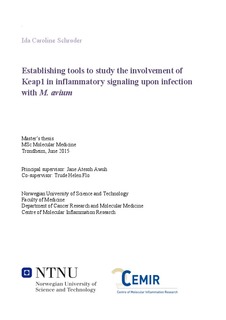| dc.description.abstract | Mycobacterium avium is a non-tuberculous mycobacteria that causes opportunistic infections in
immunocompromised individuals such as AIDS patients. The pathogen is receiving more attention
due to increasing resistance towards several antibiotics, and a high degree of genetic variability
within the strain. The treatment towards M. avium is lengthy, highlighting the importance of
elucidating the molecular mechanisms of infection in the host cells in search for novel drug targets.
M. avium infects macrophages, where they reside and avoid degradation by blocking maturation of
the phagosomes and fusion with lysosomes like the more virulent M. tuberculosis, the causative
agent of Tuberculosis. Reactive oxygen species released due to activation of Pattern recognition
receptors are thought to be important for killing intracellular mycobacteria, but excessive amounts
could be damaging to the cells. Keap1 is a sensor for ROS and a substrate adaptor for the Cullin3-
based E3 ubiquitin ligase, shown to regulate IKKβ and NF-kB signaling among other important
targets. Our group has shown that Keap1 is recruited to mycobacterial phagosomes and regulates
inflammatory signaling in human primary macrophages. The study further raised the evidence for a
direct or indirect regulation of TBK1, involved in the IRF-pathways and production of type 1
Interferons. In addition it suggests the role of Keap1’s contribution to increased survival of M.
avium intracellulary. The limitations with the use of primary macrophages due to donor variations
and difficulties in modulating protein levels, further addressed the need for a macrophage-like
model cell-line to further detail the mechanism of Keap1’s regulation of IKKβ and TBK1 using
transfection or transduction of tagged full-length Keap1 and deletion constructs of Keap1.
In this project we examined the U373-CD14 and THP1 cell-lines for response towards M. avium,
both phagocytic clearance and inflammatory cytokine responses. As the U373-CD14 cell-line did
not show a high up-regulation of the cytokines of interest, the cell-line was transiently transfected
with the endogenously absent TLR2 and TLR8, and an increased response was observed towards
infection, especially for TLR2 transfected cells. But the transient transfection displayed low
efficiency in the cells, and it was decided to modify the cell-line with lentiviral transduction and
gateway cloning with TLR2 and TLR8 in separate cell-lines. The U373-CD14 TLR2 cell-line
responded to M. avium with a significant high up-regulation of TNF-α and IL-8, and a significant
low up-regulation of IFNβ, which highlighted the importance of the receptor for M. avium induced
inflammation. The TLR8- expressing cell-line did not display an efficient up-regulation of screened
cytokines towards M. avium, and this could either be explained by the short infection time or the
incompetence of the TLR8 receptor in infection because of absent components in the pathway.
This project has provided new tools to study the regulation of IKKβ and TBK1 by Keap1 upon M.
avium infection. In addition it has raised new questions regarding the TLR8 receptor’s role in
mycobacteria infection, and highlighted the importance of TLR2 for an efficient immune response.
It further remains to investigate whether the knockdown of Keap1 leads to an up-regulation of the
cytokines of interest, and to reveal the regulation mechanisms of the kinases upon infection. | nb_NO |
